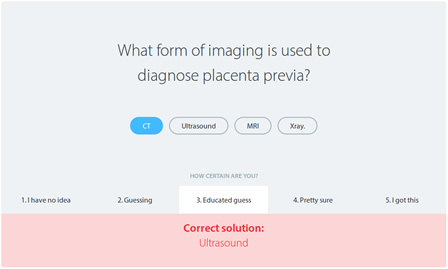Family Medicine Question Bank
1,500+ questions to help you master the Family Medicine Board Exam
Get started with our sample questions below!
1,500+ Unique Questions
Our collection of questions is crafted to help you reinforce key concepts addressed by ABFM. Similar to the exam, you’ll have the opportunity to practice a mix of clinical vignettes as well as other general multiple choice questions.
Our collection of questions is crafted to help you reinforce key concepts addressed by ABFM. Similar to the exam, you’ll have the opportunity to practice a mix of clinical vignettes as well as other general multiple choice questions.


3,000+ Integrated Flashcards
Each Family Medicine practice question includes flashcards containing bite-sized information that helps you reinforce the key concepts you need to master topics. Want to practice with just flashcards? Sign up for our standalone flashcards module.
Each Family Medicine practice question includes flashcards containing bite-sized information that helps you reinforce the key concepts you need to master topics. Want to practice with just flashcards? Sign up for our standalone flashcards module.

500+ Integrated Mnemonics
Learn better with mnemonic aids? Our Family Medicine questions list relevant mnemonics that will help you understand key concepts in a memorable way.
Learn better with mnemonic aids? Our Family Medicine questions list relevant mnemonics that will help you understand key concepts in a memorable way.


Practice questions from 100+ diagnostic exam categories
Our Family Medicine question bank is organized into medical and diagnostic categories so you can easily filter for questions you are looking for. Sign up today and start practicing questions across 15 medical exam categories and over 100 diagnostic exam categories.
Our Family Medicine question bank is organized into medical and diagnostic categories so you can easily filter for questions you are looking for. Sign up today and start practicing questions across 15 medical exam categories and over 100 diagnostic exam categories.

Interactive Dashboard
Keep a tab on your vitals with our interactive dashboard. Featuring multiple views, it displays your performance metrics across Family Medicine categories over time. You can quickly and easily track your performance in each category. In addition, you can see how well you stack up against your peers!
Keep a tab on your vitals with our interactive dashboard. Featuring multiple views, it displays your performance metrics across Family Medicine categories over time. You can quickly and easily track your performance in each category. In addition, you can see how well you stack up against your peers!


Searchable glossary
Our Family Medicine platform contains a searchable reference list of lab results, glossary terms, and generic drugs.
Our Family Medicine platform contains a searchable reference list of lab results, glossary terms, and generic drugs.

Keyword searchable questions
Suddenly recall a hypertension-related question you want to review? Knowmedge's quick keyword and filter search features give you immediate results - saving you unnecessary time looking through all the questions.
Suddenly recall a hypertension-related question you want to review? Knowmedge's quick keyword and filter search features give you immediate results - saving you unnecessary time looking through all the questions.


Notes, highlights, flags
Make our questions your own by adding notes, highlights, and flags.
Make our questions your own by adding notes, highlights, and flags.








